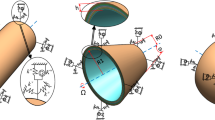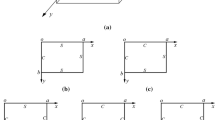Abstract
Mapping an irregular domain into a square one is a common technique in analyzing problems of plates and shells with irregular shapes. For the irregular shape without four corners such as the elliptical shape, the difficulty arises that the Jacobian determinant is zero at the corner points. An efficient quadrature method is presented to analyze the transverse vibration of thin plates with an elliptical shape. To circumvent the above-mentioned difficulty, Gauss quadrature is used in numerical integration. Besides, derivative degrees of freedom are not used, and a boundary point is modeled by two nodes separated by a very small distance. Since the nodes are not coinciding with integration points, a way indirectly using the differential quadrature law is employed to derive the explicit formulas to ease the programming. A convergence study is performed. Free vibration of elliptical plates with continuous and discontinuous edge conditions is analyzed to demonstrate the efficiency of the developed rotation-free weak-form quadrature method.








Similar content being viewed by others
References
Bathe, K.J.: Finite Element Procedures in Engineering Analysis. Prentice-Hall Inc, Englewood Cliffs, New Jersey (1982)
Yang, T.Y.: Finite Element Structural Analysis. Prentice-Hall Inc, Englewood Cliffs, New Jersey (1986)
Zienkiewicz, O.C., Taylor, R.L.: The Finite Element Method for Solid and Structural Mechanics, 6th edn. Elsevier, Oxford (2005)
Duong, T.X., Roohbakhshan, F., Sauer, R.A.: A new rotation-free isogeometric thin shell formulation and a corresponding continuity constraint for patch boundaries. Comput. Methods Appl. Mech. Eng. 316, 43–83 (2017)
Zhong, H., Yue, Z.G.: Analysis of thin plates by the weak form quadrature element method. Sci. China Phys. Mech. 55, 861–871 (2012)
Cheung, Y.K., Tham, L.G., Li, W.Y.: Free vibration and static analysis of general plates by spline finite strip method. Comput. Mech. 3, 187–197 (1988)
Li, W.Y., Cheung, Y.K., Tham, L.G.: Spline finite strip analysis of general plates. ASCE J. Eng. Mech. 112, 43–54 (1986)
Wei, G.W.: Discrete singular convolution for the solution of the Fokker-Planck equations. J. Chem. Phys. 110, 8930–8942 (1999)
Wei, G.W.: Discrete singular convolution for beam analysis. Eng. Struct. 23, 1045–1053 (2001)
Wei, G.W., Zhao, Y.B., Xiang, Y.: A novel approach for the analysis of high-frequency vibrations. J. Sound Vib. 257, 207–246 (2002)
Wang, X., Yuan, Z., Deng, J.: A review on the discrete singular convolution algorithm and its applications in structural mechanics and engineering. Arch Comput. Method E 27(5), 1633–1660 (2020)
Civalek, Ö.: Use of eight-node curvilinear domains in discrete singular convolution method for free vibration analysis of annular sector plates with simply supported radial edges. J. Vib. Control 16, 303–320 (2010)
Gürses, M., Akgöz, B., Civalek, Ö.: Mathematical modeling of vibration problem of nano-sized annular sector plates using the nonlocal continuum theory via eight-node discrete singular convolution transformation. Appl. Math. Comput. 219, 3226–3240 (2012)
Akgöz, B., Civalek, Ö.: Static and dynamic response of sector-shaped graphene sheets. Mech. Adv. Mater. Struct. 23, 432–442 (2016)
Tornabene, F., Fantuzzi, N., Ubertini, F., Viola, E.: Strong formulation finite element method based on differential quadrature: a survey. Appl. Mech. Rev. 67, 020801 (2015)
Bert, C.W., Malik, M.: The differential quadrature method for irregular domains and application to plate vibration. Int. J. Mech. Sci. 38, 589–606 (1996)
Saviz, M.R.: Electro-elasto-dynamic analysis of functionally graded cylindrical shell with piezoelectric rings using differential quadrature method. Acta Mech. 228, 1645–1670 (2017)
Shojaee, M., Setoodeh, A.R., Malekzadeh, P.: Vibration of functionally graded CNTs-reinforced skewed cylindrical panels using a transformed differential quadrature method. Acta Mech. 228, 2691–2711 (2017)
Cai, D., Zhou, G., Wang, X.: On mapping irregular plates without four corners into a regular domain. Appl. Math. Lett. 117, 107082 (2021)
Xing, Y., Liu, B.: High-accuracy differential quadrature finite element method and its application to free vibrations of thin plate with curvilinear domain. Int. J. Numer. Methods Eng. 80, 1718–1742 (2009)
Striz, A.G., Chen, W.L., Bert, C.W.: Free vibration of plates by the high accuracy quadrature element method. J. Sound Vib. 202, 689–702 (1997)
Wang, X., Yuan, Z., Jin, C.: Weak form quadrature element method and its applications in science and engineering: a state-of-the-art review. Appl. Mech. Rev. 69, 030801 (2017)
Zhang, R., Zhong, H., Yao, X., Han, Q.: A quadrature element formulation of geometrically nonlinear laminated composite shells incorporating thickness stretch and drilling rotation. Acta Mech. 231, 1685–1709 (2020)
Wang, X., Yuan, Z., Jin, C.: A general integration scheme in quadrature element method. Appl. Math. Lett. 105, 106305 (2020)
Jin, C., Wang, X., Ge, L.: Novel weak form quadrature element method with expanded Chebyshev nodes. Appl. Math. Lett. 34, 51–59 (2014)
Onate, E., Zarate, F.: Rotation-free triangular plate and shell elements. Int. J. Numer. Methods Eng. 47, 557–603 (2000)
Brunet, M., Sabourin, F.: Analysis of a rotation-free 4-node shell element. Int. J. Numer. Methods Eng. 66, 1483–1510 (2006)
Nguyen-Thanh, N., Zhou, K., Zhuang, X., Areias, P., Nguyen-Xuan, H., Bazilevs, Y., Rabczuk, T.: Isogeometric analysis of large-deformation thin shells using RHT-splines for multiple-patch coupling. Comput. Methods Appl. Mech. Eng. 316, 1157–1178 (2017)
Wang, X., Striz, A.G., Bert, C.W.: Free vibration analysis of annular plates by the DQ method. J. Sound Vib. 164, 173–175 (1993)
Timoshenko, S., Woinowsky-Krieger, S.: Theory of Plates and Shells, 2nd edn. McGraw-Hill, New York (1959)
Duan, G., Wang, X., Jin, C.: Free vibration analysis of circular thin plates with stepped thickness by the DSC element method. Thin-Walled Struct. 85, 25–33 (2014)
Civalek, Ö.: Discrete singular convolution method and applications to free vibration analysis of circular and annular plates. Struct. Eng. Mech. 29(2), 237–240 (2008)
Huang, C.S., Leissa, A.W., McGee, O.G.: Exact analytical solutions for the vibrations of sectorial plates with simply supported radial edges. J. Appl. Mech. 60, 478–483 (1993)
Wang, X., Yuan, Z.: Techniques for vibration analysis of hybrid beam and ring structures with variable thickness. Comput. Struct. 206, 109–121 (2018)
Wang, X.: Differential quadrature and differential quadrature based element methods: Theory and applications. Butterworth-Heinemann, Oxford (2015)
Boyd, J.P.: A numerical comparison of seven grids for polynomial interpolation on the interval. Comput. Math. Appl. 38, 35–50 (1999)
Wang, X., Yuan, Z.: Three-dimensional vibration analysis of curved and twisted beams with irregular shapes of cross-sections by sub-parametric quadrature element method. Comput. Math. Appl. 76, 1486–1499 (2018)
Lam, K.Y., Liew, K.M., Chow, S.T.: Use of two-dimensional orthogonal polynomials for vibration analysis of circular and elliptical plates. J. Sound Vib. 154, 261–269 (1992)
Leissa, A.W., Narita, Y.: Natural frequencies of simply supported circular plates. J. Sound Vib. 70, 221–229 (1980)
Narita, Y.: Free vibration analysis of orthotropic elliptical plates resting on arbitrarily distributed point supports. J. Sound Vib. 108, 1–10 (1986)
Narita, Y.: Natural frequencies of free, orthotropic elliptical plates. J. Sound Vib. 100, 83–89 (1985)
Kim, C.S., Dickinson, S.M.: On the lateral vibration of thin annular and circular composite plates subject to certain complicating effects. J. Sound Vib. 130, 363–377 (1989)
Singh, B., Chakraverty, S.: On the use of orthogonal polynomials in the Rayleigh-Ritz method for the study of transverse vibration of elliptic plates. Comput. Struct. 43, 439–443 (1992)
Jin, C., Wang, X.: Accurate free vibration of functionally graded skew plates. T. Nanjing Univ. Aeronaut. Astronaut. 34, 188–194 (2017)
Acknowledgements
The partial supports from the National Natural Science Foundation of China (Grant No. 52005256), the Natural Science Foundation of Jiangsu Province (Grant No. BK20190394), Jiangsu Post-doctoral Research Funding Program (Grant No. 2020Z437), the Shanghai Aerospace Science and Technology Innovation Fund (Grant No. SAST2018-071), the Fundamental Research Funds for the Central Universities (Grant No. NS2019001), and the Priority Academic Program Development of Jiangsu Higher Education Institutions are sincerely acknowledged.
Author information
Authors and Affiliations
Corresponding authors
Additional information
Publisher's Note
Springer Nature remains neutral with regard to jurisdictional claims in published maps and institutional affiliations.
Appendix
Appendix
The general shape functions of a 16-node Serendipity element with nodes of any type are given below:
where \(x_{p}\)(\(0 < x_{p} < 1\)) is shown in Fig. 1c, \(\tau = - 2x_{p}^{2} , \, \alpha = 4(x_{p}^{2} - x_{p}^{4} ), \, \beta = (1 + x_{p} )/2\), and \(\, \gamma = (1 - x_{p} )/2\).
Rights and permissions
About this article
Cite this article
Cai, D., Wang, X. & Zhou, G. An efficient quadrature method for vibration analysis of thin elliptical plates with continuous and discontinuous edge conditions. Acta Mech 232, 2575–2593 (2021). https://doi.org/10.1007/s00707-021-02971-0
Received:
Revised:
Accepted:
Published:
Issue Date:
DOI: https://doi.org/10.1007/s00707-021-02971-0




